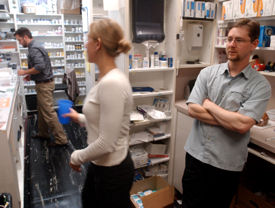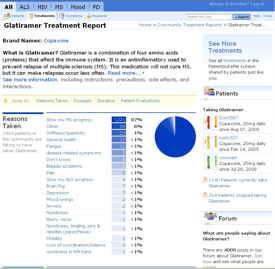Two-pronged plan to attack prediabetes
Until recently, internists had very little guidance on how to treat prediabetes and reduce the risk of the full-blown disease. The most recent advice: Treat it early, with simple lifestyle changes.
Fifty-seven million Americans. Three hundred fourteen million people worldwide.
By the numbers, prediabetes is clearly not an orphan disease. Yet, until recently, internists had very little guidance on how to treat patients who have the condition and reduce their risk of developing full-blown diabetes.

Earlier this year, the American Diabetes Association (ADA) issued updated recommendations on screening and prevention or delay of diabetes. Then, in July, the American College of Endocrinology (ACE) convened a consensus conference on the diagnosis and management of prediabetes.
“This was the first true scientific summit on prediabetes,” said Daniel Einhorn, MD, a member of the ACE task force on preventing diabetes. Experts from around the world gathered to apply current research to a number of prediabetes issues, including diagnostic and screening criteria, treatment goals and appropriate therapy. “What we realized is that this gap between normal and overt diabetes is not a gap that is benign,” said Dr. Einhorn.
However, given the limitations of existing research on prediabetes, even the new guidance released by the experts is uncertain, he cautioned. “It's a consensus conference because we don't really know for sure. There's no consensus conference on gravity.”
Still, the experts were certain enough to make a few strong statements about appropriate treatment of prediabetes (available online) . “We feel very strongly that there needs to be a two-pronged approach: one directed at glucose, one directed at cardiovascular risk,” Dr. Einhorn said.
Cardiovascular risks
The second prong is, in some ways, the simpler of the two. After a diagnosis of prediabetes, which the consensus defined as impaired fasting glucose (100-125 mg/dL), impaired glucose tolerance (140-199 mg/dL) or metabolic syndrome, patients should be treated to the same cardiovascular goals as actual diabetics, they said.
That means using statins to get LDL cholesterol to 100 mg/dL and non-HDL to 130 mg/dL or below, and treating blood pressure to 130/80 mm Hg or less, in addition to low-dose aspirin for anyone without excess bleeding risk. “Although data is limited, the safety and ease of therapy for blood pressure and lipids is such that being proactive is defensible,” explained the consensus report.
The recommendations are based on research, including the Framingham, DREAM and Nurses Health studies, which found significantly increased (in some cases almost double the normal) cardiovascular risk in people with prediabetes.
The endocrinology experts pointed to metabolic syndrome as a particularly important risk factor. “If you have impaired glucose tolerance or impaired fasting glucose and central obesity, those are the people at highest risk. Those people need to be watched like hawks,” said George Grunberger, FACP, a member of the consensus writing panel.
The consensus also favored monitoring and treating patients' elevated glucose levels, but the specifics are bit trickier. The ADA's recommendations made the first headlines on this issue when they said that metformin could be considered in patients who were at very high risk of developing diabetes, which the organization defined as IFG and IGT, obesity, age under 60, plus additional risk factors.
Controversy ensued because metformin is approved by the FDA only to treat diabetes, not its precursor. “It is the first time that I know of that there is a formal recommendation for recommending a drug off-label,” said Irl B. Hirsch, FACP, chair of the ADA Professional Practice Committee.
The ACE group made cautious, but similar, suggestions that pharmacologic therapy, specifically metformin or acarbose (and even thiazolidinediones in some cases), could be used in higher risk patients, such as those with two out of three of the diagnostic criteria (IFG, IGT, metabolic syndrome) or worsening glycemia, cardiovascular disease, nonalcoholic fatty liver disease, history of gestational diabetes or polycystic ovary syndrome.
The statement also emphasizes that prescribing decisions should be made carefully and individually, and noted that no medications are approved for prevention of diabetes. “If no drug is approved, and you give a drug to your patient and something happens, you're liable. As an organization, it's very hard to recommend something that has not been FDA-approved,” said Yehuda Handelsman, FACP, program chair of the ACE task force.
The group did consider changing the criteria for a diagnosis of diabetes. “If you define diabetes as a fasting glucose of 126 or more, what is 124? Is that fine?” asked Dr. Einhorn. “When the current diagnosis of diabetes was decided upon, it was based on the data they had at the time on when the benefits of treating may not have exceeded the risks of therapy. There is evidence that the cutoff point for diagnosing diabetes along the continuum of risk should be moved in favor of earlier intervention.”
Still, the group decided that the negative social ramifications of classifying more patients as diabetic (such as health insurance rejections) outweighed the potential positives, according to Dr. Handelsman. “There is not enough evidence to show that a definition change is necessary,” he said.
Screening cost-effectively
The lack of evidence also affects decisions about who to screen for pre- and frank diabetes.
The ACE panel found sufficient data to support screening a large segment of the population, including overweight or obese people and those of non-Caucasian ancestry. (See for full list of risk factors.) The update to ADA recommendations called for screening anyone who is overweight or obese and has an additional diabetes risk factor.
Based on an evidence review published in the June 3 Annals of Internal Medicine, however, the U.S. Preventive Services Task Force found little direct evidence for targeted or mass diabetes screening. The group did recommend screening asymptomatic adults with sustained blood pressure of greater than 135/80, and noted that screens could also be considered for some people with cardiovascular risk factors.
In sum, the task force found that screening was worthwhile for people who, if they were found to have diabetes, would be prescribed blood-pressure, lipid-lowering or aspirin therapy. The review also looked at the effectiveness of interventions to reduce progression of prediabetes to diabetes, and found sparse data on long-term health or economic outcomes.
“Most information comes from economic models of screening followed by appropriate treatment,” said lead author Susan L. Norris, MD. “Economic models are only as good as the data that go into them, and based on our review of the evidence, there are many gaps in the literature on the relationship between screening for diabetes and prediabetes and the health outcomes important to patients.”
The consensus statement cited some studies finding that interventions reduced diabetic complications in patients with impaired glucose tolerance or fasting glucose, but nothing that addressed the question of long-term effectiveness.
Lifestyle comes first
Another difficulty that the experts have is getting physicians and patients to comply with the preferred solution to the prediabetes epidemic—lifestyle modification. Before physicians even consider drugs, lifestyle modification should be the cornerstone of prediabetes treatment, attempted with all patients and reinforced at every visit, the ACE report urged.
“Our lifestyle is the reason we're here,” said Etie S. Moghissi, MD, a member of the writing panel. “It's the most effective tool we have. You cannot recommend medication for 57 million people with prediabetes.”
Dr. Einhorn agreed. “There should never be guidelines that don't say lifestyle, lifestyle, lifestyle, then if it doesn't work pharmacology can be added on.” The problem, he acknowledged, is that making lifestyle work can be very difficult, time-intensive and costly.
“You'd think lifestyle modification would be the least expensive [therapy]. Instead, it's the most expensive because it's hardest and most time-consuming to implement,” Dr. Einhorn said.
The experts had some advice on getting patients to live healthfully (see sidebar), but their report called for societal changes, too. “In medical school, there's not a single course to teach doctors how to implement a healthy lifestyle. Education should be mandatory,” said Dr. Grunberger.
Sedentary lifestyles, busy schedules and insurance reimbursement were all cited as obstacles to lifestyle modification. “In real life, neither the patient nor the primary care physician has the time to sit down and do the things that are needed to make this a success,” said Arvind R. Cavale, FACP, an endocrinologist in Feasterville, Pa.
“The only way you can get out of this morass would be to make sure there is an incentive for patients to participate and an incentive for doctors to dispense this advice,” concluded Dr. Grunberger.
However, until incentives are realigned, endocrinologists hope that the new guidance will convince primary care physicians, the main target of the consensus statement, to identify and treat their growing population of prediabetic patients. “This should be a collective wake-up call. This is not something which can be ignored,” Dr. Grunberger said.




